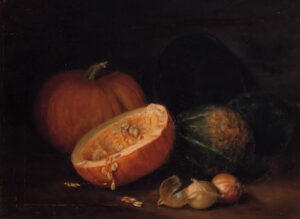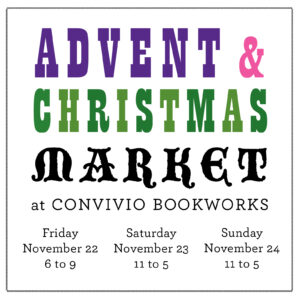Belated again! But just before Hollantide is past, here is your Convivio Book of Days for November. The calendar comes just in time for Martinmas, the Feast of St. Martin of Tours, which marks the official end to the harvest season and the last big religious celebration each year before the start of Advent. It’s also Veterans Day here in the US, Armistice Day elsewhere, marking the signing of the armistice that ended the Great War, or World War I. The cease fire that followed the signing that morning came at the eleventh hour of the eleventh day of the eleventh month, 1918. We called it Armistice Day, too, until 1954, when Congress replaced the word “Armistice” with “Veterans,” and this is the name we have given this national holiday ever since.
St. Martin of Tours was a veteran, too, but of the Roman army. He was born in 316 in the part of the vast Roman Empire that is now Hungary and became a soldier when he was a young boy. He was part of the imperial calvary (which is why he is often depicted on horseback) and was sent to serve the empire in Gaul (which is now France). At some point, though, Martin had a change of heart: he converted to Christianity and became a pacifist and refused to fight. He was imprisoned for the pacifism he preached, but eventually was released. He became a monk and founded a monastery there in France.
France, of course, is known for wine, and St. Martin, too, has much to do with wine. It is on Martinmas, traditionally, that the new wine each year is first tasted, and French Beaujolais wines are typically released on or around Martinmas. The best known story about good St. Martin involves him meeting a disheveled drunken man shivering in the cold on a bitter winter’s day; Martin saw the man, took off his own woolen cape, cut it in two with his sword, then wrapped one half around the cold man to warm him. In the Middle Ages, he was one of the more popular saints and became a patron saint of all kinds of folks, from tailors to innkeepers to the French monarchy… but perhaps St. Martin is best known as a patron saint of grape growers and winemakers, and even of those who delight in wine.
In Germany, children parade about tonight carrying St. Martin’s Day lanterns. The lanterns and the children brighten the lengthening nights come this time of year, for with Martinmas we find ourselves, by traditional reckoning of time, at the natural start of winter. The living world continues its process of shutting down and receding into itself: going underground. Trees are no longer growing above, but roots below the surface still are growing. And so the connections are strong, these darkening days, between the world of the living and the underworld of the dead.
Of course we honored these days of the dead at the start of the month with Hallowe’en and All Saints and All Souls. But the connection of Martinmas to the days of the dead is just as strong, through memory. Before the change to the Gregorian Calendar, the 11th of November was Samhain, the Celtic New Year, and so Martinmas was also long ago known as Old Hallowe’en, or Old Hallowmas Eve. Another name for Martinmas is Hollantide, and just as Halloween is a corruption of the words All Hallow’s Eve, so is Hollandtide, which comes from Hallowtide: the time of the sacred, the holy––those who have gone before. Many of our contemporary Halloween traditions come out of Hollantide traditions: the carving of turnips (replaced by pumpkins here in America) into Jack o’ Lanterns and the going door to door in search of soul cakes, which has evolved into the trick-or-treating we know today. Martinmas is a proper close to our annual season of remembrance, and with its passing we can focus on what is to come: Thanksgiving, and then Advent––the preparation for Christmas. The day is also a traditional weather marker: If ducks do slide at Hollantide, At Christmas they will swim. / If ducks do swim at Hollantide, At Christmas they will slide. / Winter is on his way / At St. Martin’s Day.
A STORY FOR MARTINMAS
I had the pleasure a couple years back of reading for you a slightly spooky tale for Martinmas: a Tirolean tale collected and retold by Diane Goode. The scary factor, to be honest, is quite minimal. It’s a fun story for kids and sleepy adults about a goose and an old woman who doesn’t know what’s good for her; I read the story for the Stay Awake Bedtime Stories series for the Jaffe Center for Book Arts. CLICK HERE for the story (and perhaps you’d like to follow along on Instagram (@stayawakebedtimestories) to learn about new Stay Awake releases).
IN THE SHOP NOW: ADVENT CALENDARS & CANDLES
I saw a fully illuminated Christmas tree in a neighbor’s house two nights ago and though it was beautiful, shimmering there in the dark, I had to stop and really think about just what time of year it was. Personally, I like advocating for a “Slow Christmas,” and I encourage you to try this slower approach, too. One of the best ways I know to do so is by keeping the season of Advent before welcoming Christmas. Advent, mind you, doesn’t even begin until the First of December this year, so while that neighbor of mine may very likely be tired of seeing their lovely Christmas tree by Boxing Day, we slower folks will get to appreciate it in its time and through the Twelve Days of Christmas (and for some of us, like us, even to Candlemas). All things in their time, I say.
Shop with us online by CLICKING HERE. And if you’re local, come see us at our new shop all the Saturdays of November from 11 AM to 5 PM at 1110 North G Street in Lake Worth Beach. And we invite you to our inaugural Advent & Christmas Market, the weekend of November 22 through 24! There will be homemade cookies to taste and lots of great shopping ideas. Friday November 22 from 6 to 9 PM, Saturday November 23 from 11 AM to 5 PM, and again on Sunday November 24 from 11 AM to 5 PM. Welcoming you to things like this: that’s one of the greatest joys about having our own shop. We’d love to see you there.

